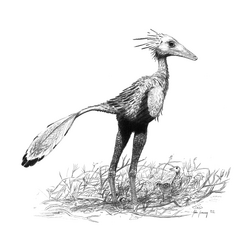| Sinornithoides Fossil range: Early Cretaceous, 125 Ma | |
|---|---|
 | |
| Scientific classification
| |
| |
Sinornithoides (meaning "Chinese bird form") is a genus of troodontid theropod dinosaur. It lived during the Early Cretaceous (Barremian stage, around 130 125 million years ago). It measured approximately 1 meter long (3 ft). It lived in Inner Mongolia, China, and probably ate invertebrates and other small prey.
Discovery[]
Sinornithoides youngi, the type species, was described in 1993 by Dale Russell and Dong Zhiming based on a fossil specimen from the Ejinhoro Formation.[1] It is represented by a holotype which is articulated and nearly complete except for the roof of the skull and the cervical and dorsal vertebrae, along with some other referred skeletal elements. The holotype is preserved in much the same roosting position as another troodontid fossil, that of Mei long, with its snout tucked under its left hand.[2]
Description[]
Sinornithoides is a relatively small non-avian theropod. In 2010, Gregory S. Paul estimated its body length at 1.1 metres, its weight at 2.5 kilogrammes.[4]
In 1994, Sinornithoides was one of the most completely known troodontids, especially as regarded the palate, but the lack of sufficient fossil material to compare it with induced Russell and Dong not to indicate any diagnostic traits.[2]
The skull of Sinornithoides is elongated and pointed. However, the head is relatively short compared to the body as a whole. The praemaxilla is short. There is a fenestra promaxillaris, a small opening in the front of the maxilla side, which is rare among troodontids. There are four premaxillary and about twenty-three maxillary teeth. The maxillary teeth have no serrations on their front edge; the denticles on the concavely curved rear edge are small. The maxillary teeth are rather recurved. The lacrimal bone lacks a pneumatic channel. In the braincase the subotic recess is large. The tips of the lower jaws do not curve towards each other but touch at their inner sides. The external mandibular fenestra is large. The dentary, lower jaw, teeth are quite pointed and have no front edge denticles; their rear edge is very straight. The holotype preserves a furcula and a basket of fifteen pairs of gastralia. The arms are weakly developed, with a slender humerus and ulna. The front top of the third metatarsal is not fully overgrown by the second and fourth metatarsals. The sickle claw of the second toe is relatively large and long for a troodontid.
Phylogeny[]
References[]
- ^ Russell, D. and Dong, Z. (1993). "A nearly complete skeleton of a new troodontid dinosaur from the Early Cretaceous of the Ordos Basin, Inner Mongolia, People's Republic of China." Canadian Journal of Earth Sciences, 30: 2163-2173.
- ^ Currie, P. and Dong, Z. (2001). "New information on Cretaceous troodontids from the People's Republic of China." Canadian Journal of Earth Sciences, 38: 1753–1766. DOI: 10.1139/cjes-38-12-1753
External links[]
- Troodontidae at Thescelosaurus!